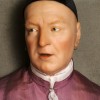The world’s first exhibition on wax portraits will analyse a field that has been studied very little by art historians: that of life-size wax figures. This fascinating subject has recently attracted the attention of numerous contemporary artists, but has never had a specific exhibition devoted to it.
The project was inspired by two fortunate coincidences, the existence of a series of life- size wax portraits in Venice’s public collections and churches, and the centenary of the publication of Geschichte der Porträtbildnerei in Wachs (“History of Portraiture in Wax”), written by the famous Viennese art historian Julius von Schlosser and the first work devoted to the history of wax portraits. A superb Italian translation of Schlosser’s work by Andrea Daninos has recently been published, complete with an extensive and detailed critical commentary.
The Venetian exhibition is the outcome of more than three years of research and, for the first time, it brings together nearly all of the extant sculptures in Italy, most of which unpublished or never displayed before.
The rooms of the Palazzo Fortuny, considered a major attraction for art lovers visiting Venice, will be transformed into a veritable wax museum, re-creating the fascinating atmosphere that always surrounds such displays.
The exhibition route begins by examining casts and funeral masks. The first section will feature wax death masks of Venetian doges from the 18th century, the sole examples of the custom of using wax “doppelgängers” at funerals. The cast of the deceased replaced his body, concealed in the coffin, and his effigy thus bore witness to the continuity of power, leaving a realistic and very evocative impression on the public.
The exhibition will also present the only visual testimony we have today of life-size votive figures that no longer exist: Vincenzo Panicale’s Libro dei miracoli. The manuscript from the early 17th century contains a series of watercolours documenting the ex-votos that once filled the sanctuary of Santa Maria della Quercia in Viterbo, and it served as a catalogue of existing waxworks that made it possible to reproduce the statues faithfully if they were damaged or ruined.
The exhibition itinerary will continue with the faces of saints and criminals, two recurrent subjects in the ceroplastic tradition. The former are represented by twelve busts of Franciscans, made of wax and with glass eyes and real hair; datable to the 18th century, they are unique in religious iconography made of wax. They will be juxtaposed with a series of twelve wax portraits of criminals modelled in the late 19th century by Lorenzo Tenchini, a pupil of Cesare Lombroso. Three wax busts, the only Italian examples of anthropological portraits, will be displayed alongside them. Depicting a Caucasian, an Ethiopian and a Bedouin, they were made by Remigio Lei, a wax modeller from Modena, in the second half of the 19th century for the ethnographic-anthropological collection of the local anatomical museum.
The main section of the exhibition, devoted to wax portraiture in Italy, is introduced by two life-size figures of 18th-century Venetian children in period costumes. The two works, cited by Schlosser and Mario Praz (the latter compared them to the leading figures in Henry James’s novel The Turn of the Screw), have long been in the storerooms of the Palazzo Mocenigo and have not been displayed publicly for decades. Their unrivalled craftsmanship and disturbing realism will unquestionably astonish visitors. The Bologna school, in which the art of life-size wax portraiture was extremely popular, will be represented by a series of works by Luigi Dardani, Filippo Scandellari and Angelo Gabriello Piò.
The exhibition will end with several sculptures by two artists who worked outside Italy to exhibit wax figures, anticipating Madame Tussaud’s famous museum. This section will present the portrait of Marie Caroline de Bourbon-Sicile by Joseph Müller-Deym, a mysterious Austrian nobleman who owned a famous wax museum in Vienna in the 18th century, and the works that the Piedmontese Francesco Orso, who opened a similar wax exhibition in Paris during the period of the French Revolution, made for the Savoyard court: the busts of Victoria of Savoy-Soissons, Victor Amadeus III of Savoy and Maria Antonia Ferdinanda de Bourbon.
The exhibition catalogue, edited by Andrea Daninos, will be published by Officina Libraria in two editions (English and Italian). It will include entries for all the works on display, written with the collaboration of numerous scholars, as well as colour illustrations and four essays: by Daninos on the history of wax portraiture in Italy, Giovanni Ricci on funerals in effigy in Italy, Guido Guerzoni on Renaissance waxworks, and Emanuele Trevi on the relationship between wax and literature.
_
The exhibition is realised with the support of Pandora Old Masters New York and with the contribution for the restoration of Etro Spa.
Catalogue Officina Libraria
Essays by Andrea Daninos, Guido Guerzoni, Giovanni Ricci, Emanuele Trevi
BUY ONLINE THE CATALOGUE OF THE EXHIBITION >>>
_
The exhibition is part of the program Spring at Palazzo Fortuny with the exhibition Diana Vreeland after Diana Vreeland curated by Judith Clark and Maria Luisa Frisa



